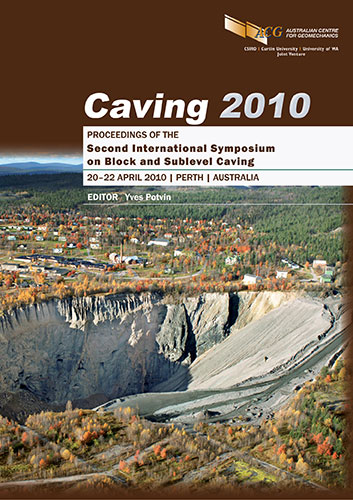Integration of 3D numerical modelling and InSAR deformation monitoring to characterise block caving induced surface subsidence

|
Authors: Woo, KS; Eberhardt, E; Ghuman, P; Stead, D |
DOI https://doi.org/10.36487/ACG_rep/1002_12_Woo
Cite As:
Woo, KS, Eberhardt, E, Ghuman, P & Stead, D 2010, 'Integration of 3D numerical modelling and InSAR deformation monitoring to characterise block caving induced surface subsidence', in Y Potvin (ed.), Caving 2010: Proceedings of the Second International Symposium on Block and Sublevel Caving, Australian Centre for Geomechanics, Perth, pp. 205-216, https://doi.org/10.36487/ACG_rep/1002_12_Woo
Abstract:
Although the economic benefits of block caving are appealing, the mass extraction of ore inevitably causes significant ground deformations that may adversely affect sensitive infrastructure on surface. Sophisticated 3D numerical modelling has recently been employed as a means to help assess subsidence magnitudes, extent and impacts. At the same time, uncertainty and variability associated with geological heterogeneity and rock mass properties results in model uncertainty and the need for models to be calibrated and constrained. This study examines the use of 3D numerical methods for modelling block caving induced surface subsidence and means to calibrate and constrain these complex models. The latter is addressed through the use of high-resolution satellite Interferometric Synthetic Aperture Radar (InSAR) data acquired through Canada’s second generation radar satellite, RADARSAT-2. Preliminary results are presented for a detailed multi-disciplinary study involving the Palabora block cave mine in South Africa.
References:
Beck, D. and Pfitzner, M. (2008) Interaction between deep block caves and existing, overlying caves or large open pits, in Proceedings 5th International Conference and Exhibition on Mass Mining, MassMin 2008, H. Schunnesson and E. Nordlund (eds), 9–11 June 2008, Luleå, Sweden, Luleå University of Technology Press, Luleå,
pp. 381–391.
Flores, G. and Karzulovic, A. (2003) Geotechnical guideline for a transition from open pit to underground mining: Geotechnical characterization, Report to International Caving Study II, Julius Kruttschnitt Mineral Research Centre, Brisbane, 114 p.
Gilbride, L.J., Free, K.S. and Kehrman, R. (2005) Modeling block cave subsidence at the Molycorp, Inc., Questa mine, in Proceedings 40th US Rock Mechanics Symposium, Anchorage, paper 05-881.
Itasca Consulting Group (2009) FLAC3D (Fast Lagrangian Analysis of Continua in 3Dimensions), Version 4.0, Itasca Consulting Group, Inc: Minneapolis.
Karzulovic, A., Cavieres, P. and Pardo, C. (1999) Caving subsidence at El Teniente mine, in Proceedings Symposium on Mining Engineering, SIMIN99, Santiago.
Laubscher, D.H. (2000) Block Cave Manual, Design Topic: Subsidence, Julius Kruttschnitt Mineral Research Centre, Brisbane.
Lupo, J. (1998) Large-scale surface disturbance resulting from underground mass mining, International Journal of Rock Mechanics and Mining Science and Geomechanics Abstracts, Vol. 35, No. 4/5, p. 399.
National Coal Board (1975) Subsidence Engineers Handbook, 2nd edition, Coal Board Mining Department, London,
p. 111.
Piteau Associates (2000) Numerical Modelling of the Effects of Open Pit Deepening and Block Cave Mining on the Stability of the East and North Walls, Palabora Mining Company Phalaborwa, South Africa Copper Open Pit Project 686-UG, 138 p.
Rabus, B., Eberhardt, E., Stead, D., Ghuman, P., Nadeau, C., Woo, K., Severin, J., Styles, T. and Gao, F. (2009) Application of InSAR to constrain 3D numerical modelling of complex discontinuous pit slope deformations, in Proceedings 3rd International Symposium on Rock Slope Stability, Slope Stability 2009, Santiago, Chile, 9–11 November, Universidad de los Andes, CD-ROM, 11 p.
Sainsbury, B., Pierce, M.E. and Mas Ivars, D. (2008) Analysis of caving behaviour using a synthetic rock mass— ubiquitous joint rock mass modelling technique, in Proceedings 1st Southern Hemisphere International Rock Mechanics Symposium, SHIRMS08, Vol. 1 – Mining and Civil, Y. Potvin, J. Carter, A. Dyskin and R. Jeffrey (eds), Australian Centre for Geomechanics, Perth, Australia, pp. 343–252.
van As, A. (2003) Subsidence Definitions for Block Caving Mines, Technical Report, Rio Tinto Technical Services,
59 p.
Vyazmensky, A. (2008) Numerical Modelling of Surface Subsidence Associated with Block Cave Mining Using a Finite Element/Discrete Element Approach, PhD Thesis, Simon Fraser University, 239 p.
Vyazmensky, A., Stead, D., Elmo, D. and Moss, A. (2009) Numerical analysis of block caving-induced instability in large open pit slopes: A finite element/discrete element approach, Rock Mechanics and Rock Engineering, .
Woo, K., Eberhardt, E. and van As, A. (2009) Characterization and empirical analysis of mining-induced subsidence over block caving operations, in Proceedings Symposium and Workshops on Rock Engineering in Difficult Conditions, 3rd Canada-US Rock Mechanics Symposium, Toronto, M. Diederichs and G. Giovanni (eds).
Zebker, H.A. and Rosen, P.A. (1994) On the derivation of coseismic displacement fields using differential radar interferometry: The Landers earthquake, Journal of Geophysical Research, Vol. 99, No. B10, p. 19, pp. 617–619.
© Copyright 2025, Australian Centre for Geomechanics (ACG), The University of Western Australia. All rights reserved.
View copyright/legal information
Please direct any queries or error reports to repository-acg@uwa.edu.au
View copyright/legal information
Please direct any queries or error reports to repository-acg@uwa.edu.au